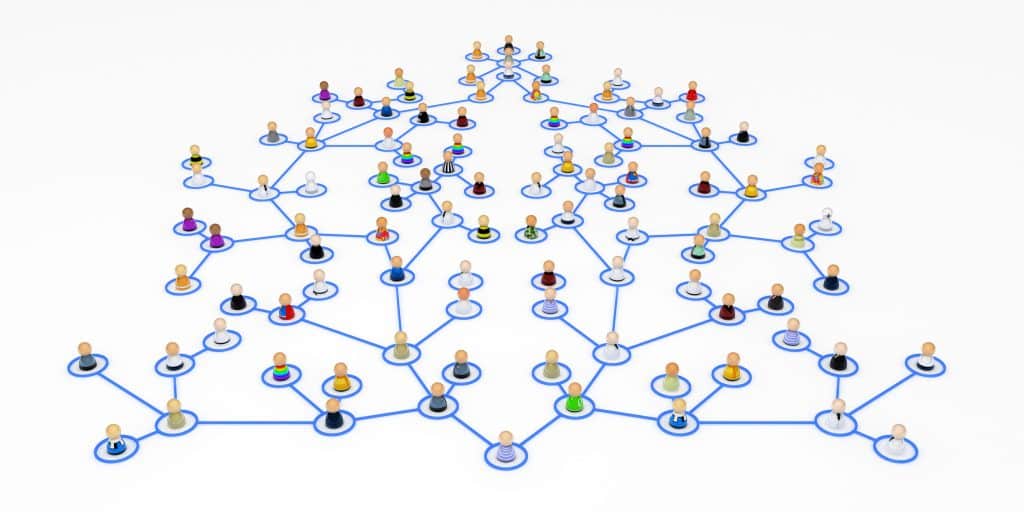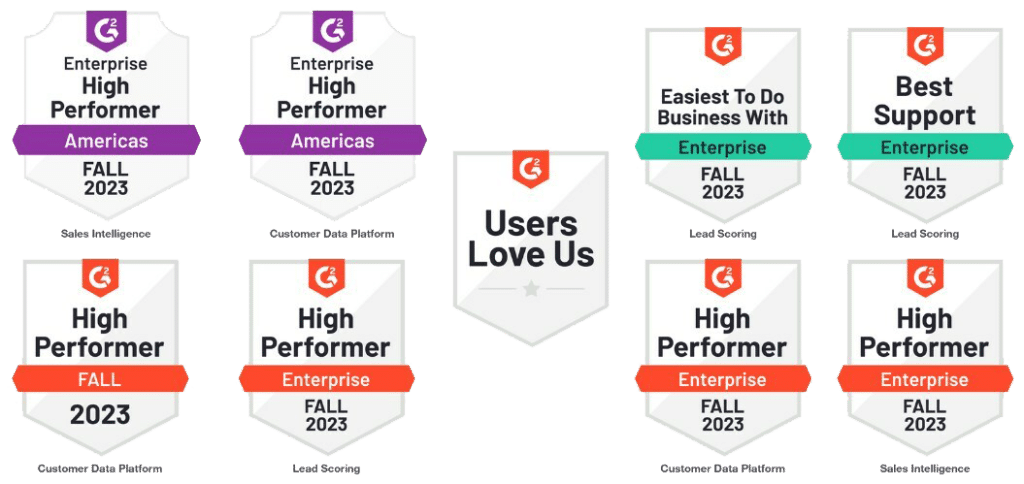-
10 Ways You’re Losing with Static Data

Sales and marketing teams rely on a myriad of customer data to do their jobs. Unfortunately, that data often leads to more problems than benefits because of its siloed, unstructured nature. Static data, which refers to data that does not change once it is created, has several inherent problems and limitations. Acquiring a variety of […]
-
10 Signs Your Buyer Data is Causing Problems for Sales & Marketing

Recognizing signs that your customer data is causing problems for your sales and marketing teams and addressing them quickly is crucial for maintaining effective operations and achieving business goals with data-driven decision making. It all starts with high-quality data. Personalized campaigns, territory planning, lead routing, lead prioritization, cross sell/up sell, analysis, reporting, and the implementation […]
-
10 Benefits to Mapping Hierarchies Across Your Buyer Data

If you’re part of a sales or marketing team, then you’re used to leveraging numerous systems full of people, company and account-level data in an attempt to decide where to focus your resources and effort – but how many of you have hierarchies mapped so that you can explore how your profiles for people and […]
-
Leadspace MAPs: Identity Resolution for Companies & Hierarchies

As I’ve discussed in recent blogs, one of the main issues sales and marketing teams experience is not getting enough value from their data. Unfortunately, simply adding more data hasn’t been solving that issue. The reason for this lack of value is that customer or buyer data is naturally fragmented. The data comes in many […]
-
Leadspace MAPs: The Fast Fix for Your Unproductive CRM

Sales and marketers are looking at buying groups instead of job titles alone. The buying power and functions of any job title isn’t universal between different companies. In order to identify who the decision makers are at a company, we need to understand the hierarchical structure of the company and either know or take educated guesses on whether the person is in corporate or which division someone is in.
-
Forrester is Over – Don’t Go Back to Static Data!

Last week our team had the privilege of attending the Forrester B2B Summit 2024 in Austin, Texas, and it was one heck of an experience. If you took the time to attend the event, odds are that you saw the Leadspace team hustling at our booth or across the show floor in our awesome shoes […]
-
Challenge the Static Quo – Overcoming Buyer Data Obstacles

As we discussed in the previous blog, the main obstacle with operationalizing buyer data is that it is static. It takes a lot of data to build the buyer profiles that our sales and marketing teams need to effectively hone-in on closeable business. Acquiring a variety of static data from multiple vendors means that we […]
-
From Static To Dynamic: Data You Can Actually Use

B2B Sales and Marketing teams, in particular, absolutely love buyer data – they depend on it to do their jobs! Unfortunately, most companies are failing to use it to its potential. The goal is usually to use buyer data to determine who might want their product, but a company’s data is often such a mess […]
-
Easily Adopted CDPs: The Difference Between Success and Shelfware

When it comes to tools, everyone appreciates the ones that work, and usually that means they are easy to use. Unfortunately, analysts report that at any time, 25%+ of our business software is actually shelfware. Shelfware refers to software or technology solutions that have been purchased by a business but are not actively used or […]
-
Identity Resolution: The Cornerstone of Your B2B Data Strategy

Identity resolution is the unsung hero in GTM ROI. Fundamental to any sales & marketing endeavor is knowing who that buyer is – and what role they play in any buying team. It’s the difference between flying blind and flying smart. Whether or not you have a strong identity resolution framework is the main factor […]
-
Do You Really Need the Best Identity Resolution & Active Profiles Available?

Answer: Of course you do! Sales & Marketing teams know that targeting customers with incomplete and siloed data is a complex process. Having a single, comprehensive view of your customer data in one place makes it significantly easier to effectively target the right people at the right time with personalized campaigns. Unfortunately, creating active, unified […]
-
Stop Spending Money on Siloed Data. Get Pre-Blended 3rd-Party Data for Half the Cost!

As B2B marketers, we aim to deliver effective campaigns targeted at the best opportunities within our Total Addressable Market (TAM) – at the lowest cost. Doing this successfully starts with creating complete, accurate, dynamic and unified buyer profiles of people, accounts and buying centers so we can properly prioritize and target opportunities with data-driven assurance […]
-
Getting Robbed by Data Vendors? Get Best-in-Class B2B Buyer Profiles for 50% Less!

As B2B marketers, our goal is to deliver effective campaigns targeted at the best opportunities that exist within our Total Addressable Market (TAM) – at the lowest possible cost. This involves identifying our Total Addressable Market (TAM), developing our Ideal Customer Profile (ICP), and then comparing our ICP throughout our TAM to determine which opportunities […]
-
Leadspace Earned 9 Awards by G2 Across Multiple Categories in Fall 2023 Report!

Today, we’re excited to report that Leadspace has once again achieved numerous awards from G2 in 2023. We earned eight new G2 high performer badges across three categories: Customer Data Platforms; Sales Intelligence; and Lead Routing in the Enterprise Grid Reports and the Enterprise Americas Regional Grid Reports for Fall 2023. In addition, Leadspace was […]
-
Are You Wasting Your Salespeople’s Time? Apply Weighted Engagement Scores in Marketing

An engagement scoring model is often the signature move for a demand generation team – and they’ve been around for a long time in the marketing world. Most campaign teams use them as a way to understand when a “lead” is ready to be routed to sales. Some teams use simple off-the-shelf models from their […]
-
AI Persona Scoring – When Job Title Guesswork Doesn’t Work

A persona refers to a representation of a user or buyer segment that is created to better understand and design for the needs, behaviors, and preferences of that group. Persona creation is common in fields like marketing, user experience (UX) design, and customer service. It’s especially useful in sales and marketing when it comes to […]
-
Lead Conversion Starts with Signals – Use Fit Scoring or Lose Business!

Identifying the best leads is essential for any company’s success as it helps focus resources and efforts on prospects most likely to become customers. In marketing, we have limited resources (employees, money, time) – we rarely have the ability to “spray and pray” with our sales & marketing efforts. Going at the wrong person before […]
-
Are Your Leads Worth Pursuing? Throw Most of Them Out!

If someone is interested in your product or service, is it necessarily true that they will convert into a paying customer in the future? Does a higher level of interest translate into higher odds of sales conversion? How do we know if the way we are measuring and assessing their interest is accurate? Is that […]
-
Relying on Intent Data Alone: More Harm than Good?

Three out of four B2B sales and marketing teams rely on intent data to prioritize ABM outreach. Intent data is incredibly important as it provides insight into which companies are searching for you – i.e. which companies are demonstrating some level of intent to use your type of product (or specific product). While that’s useful […]
-
Revenue Radar™: Finding the Right Buyers with Engagement Scores

Throughout this Revenue Radar blog series, we’ve discussed how to use Leadspace predictive AI models to determine the companies within your Total Addressable Market (TAM) who need your product (highest Fit scores), which of those companies are actually ready to buy your product (Intent scores), and which buyer Personas are best for you to pursue […]
-
Revenue Radar™: Finding the Right Type of Buyer Using Persona Scoring Models

In our last few blogs, we discussed using Fit (propensity) models to determine the companies within your TAM who need your product, and how to determine which of those companies are actually ready to buy with Intent scores. Now you need to figure out who are the right people to pursue within those companies. Does […]
-
Revenue Radar™: Finding the Right Company Using Intent Scoring Models

Finding the right type of companies within your TAM that need your product is a huge step towards closeable business, but you still need to figure out which of those companies are actually ready to buy your product – this is where intent comes into play. We can determine intent by a company’s search activities. […]
-
Revenue Radar™: Finding the Right Type of Companies Using Fit Scoring Models

Finding the right type of companies for your product by hand is a cumbersome process that’s error prone and heavily relies on guesswork. With competition at an all time high, B2B sales and marketing teams need a way to automate this process, and replace guesswork with data-driven insights to reach their customers before their competitors […]
-
Revenue Radar™: An Introduction to AI Targeting

As marketers, we aim to confidently and repeatedly deliver effective campaigns to the best opportunities within our target market – at the lowest possible cost. This means identifying our TAM (Total Addressable Market), developing our Ideal Customer Profile (ICP), and comparing our ICP throughout our TAM to determine which opportunities to focus on, then get […]
-
Leveraging Artificial Intelligence for Customer Targeting

The best way to answer this question is through a company Fit or propensity model that identifies which of these intent-surging accounts your company is most likely to close. Company Fit or propensity models compare your historical data and ICP against all the profiles within your TAM then use AI/ML-Analytics to algorithmically score them by a variety of buying signals to determine their propensity to buy your product right now – as well as indicating whether or not they’re likely to buy in the future.
-
Improving Sales Territory Management and Planning

Aligning your teams to ensure sales quotas are met has never been easy, and the current environment has only made it harder. If your sales goals are not being met, it may be time to optimize your sales territory management strategy by utilizing all available resources effectively to boost sales productivity. What Is Sales Territory […]
-
Data Decay: What, Why and How?

People and companies change every day. Companies make acquisitions, people change jobs, and intentions are dynamic. This means your data changes every day – but is your database up to date? Is the data you use to drive your business as accurate as the day you procured it? Data Decay is an issue that every […]
-
Salesforce Study: Less Complexity, Better Integrations and Immediate Cost Reductions

Pulse and Salesforce surveyed 500 IT leaders across the globe to find out 7 trends and the best practices that are reshaping IT. How are they navigating the data security complexities and pushing forward on their digital transformation goals? What are their winning strategies for retaining talent and resources? And how do they drive innovation […]
-
Moneyball ABM: Aligning Outbound with Readiness and Engagement

In the last few blogs I discussed how to discover your TAM and assign territories, then how to determine where to focus your sales and marketing efforts by using AI/ML models to score leads and understand who is ready, eager and able to buy your product. We also discussed how to turn the profiles within […]
-
Moneyball Campaigns: Map and Define Marketing Campaign Segments By Territories

In the last two blogs I discussed how to discover your TAM and assign territories, and then how to determine where to focus your sales & marketing efforts by using AI/ML models to score leads and understand who is ready and able to buy your product. Now let’s look at how to turn the profiles […]
-
Moneyball Navigation: Map Account Readiness to Your TAM

It’s always that time of year. In sales and marketing we’re always starting a new quarter, ending a new quarter, trying to create demand for the following year or just planning. We always want to start strong and grow better. Assuming you start strong – how do you grow better? How do you outsmart the […]
-
Moneyball for Sales Territory Management

It’s Q4 for most of us, and this is the time of year when revenue operations professionals spend time understanding and redefining sales territories. Sizing territories alone is next to impossible to do by hand, and the tedious process of narrowing down all of the possibilities is expensive, time consuming, and error prone. Even after […]
-
How to Double Your Account-Based Marketing Performance

Choosing ABM accounts based on gut or table stakes profiling – like firmographics – isn’t enough anymore. Successful ABM comes down to discovering your TAM, building profiles at the person, account, and buying center levels, and then comparing them against your ICP in order to focus your time and effort on the accounts most likely […]
-
5 Ways to Use Intent Data for Sales and Marketing

B2B Marketing and Sales leaders are constantly looking for the next innovative method to give them a competitive edge—particularly in driving revenue for their business. If you work in sales or marketing, there probably hasn’t been a day where you have not heard about implementing or operationalizing intent data to target and engage your prospects […]
-
What is Enterprise Profiling?

As B2B marketers, our goal is to deliver effective campaigns targeted at the best opportunities that exist within our Total Addressable Market (TAM) – at the lowest possible cost. This means identifying your TAM, developing your Ideal Customer Profile (ICP), and comparing your ICP throughout your TAM to determine which opportunities to focus on, then […]
-
Managing B2B Profiles for Full Funnel Optimization

As B2B marketers, our goal is to deliver effective campaigns targeted at the best opportunities that exist within our Total Addressable Market (TAM). Of course, this means identifying your TAM is the first step. The following steps are – developing your Ideal Customer Profile (ICP), comparing your ICP throughout your TAM to determine which opportunities […]
-
Moving Beyond Demand & ABM With B2B Customer Data Platforms

In this increasingly complex and dynamic B2B marketing environment, marketers are struggling to keep up with legacy demand and ABM strategies. Cutthroat competition and advancements in AI technologies are driving the need for B2B marketers to take full advantage of any and all tools available to stay one step ahead of their competitors. This means […]
-
What is the Difference Between B2B CDPs and B2C CDPs?

With ninety percent of companies either evaluating or deploying a CDP, the question comes up as to the difference between a B2B CDP and B2C CDP. In a recent BrightTalk webinar, Amish Sheth (Leadspace VP, Solution Engineering) explored the capabilities and differences between a business-to-business customer data platform and a business-to-consumer customer data platform. What […]